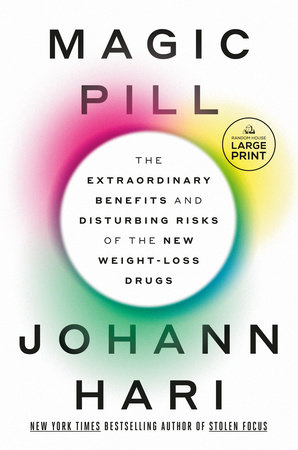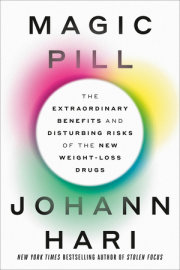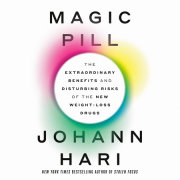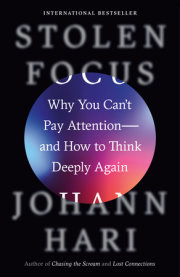Chapter 1
Finding the Treasure ChestHow the drugs work
I opened my eyes and immediately felt that something was off. Thwacking my alarm clock into silence, I lay there for five minutes, trying to figure out what it was. It was two days since I had started taking Ozempic. I felt mildly nauseous, but it was not severe—if it had happened on a normal day, it wouldn’t have stopped me from doing anything. So that wasn’t it. It took me a while to realize what it was. I always wake up ravenously hungry, but on that morning, I had no appetite at all. It was gone.
I got out of bed and, on autopilot, went through my normal morning routine. I left my flat and went to a local café run by a Brazilian woman named Tatiana, where my order is always the same: a large, toasted bread roll, filled with chicken and mayonnaise. As I sat there reading the newspapers, the food was placed in front of me, and I looked at it. I felt like I was looking at a block of wood. I took a bite. It tasted fine. Normal. I took three or four more bites, and I felt full. I left almost all of it on the plate. As I hurried out, Tatiana called after me, “Are you sick?”
I went to my office and wrote for three hours. Normally, by noon, I would have a snack, something small and sugary, and then at about 1 p.m. would go down the street to a local Turkish café for lunch. It got to 2 p.m. and I wasn’t hungry. Again, my sense of routine kicked in, and again, I went to the café and asked for my standard order, a large Mediterranean lamb with rice and bread. I managed to eat a third of it. It seemed to me for the first time to be incredibly salty, like I was drinking seawater.
I wrote some more, and at 7 p.m. I left my office to go and meet a friend in Camden Market, one of my favorite parts of London. We walked between the stalls, staring at food from every part of the world. Normally, I could stuff my face from three different stalls, but that night, I had no hunger. I couldn’t even manage a few mouthfuls. I went home, feeling exhausted, and went to sleep at the unprecedentedly early time of 9 p.m.
As that first week passed, it felt like the shutters had come down on my appetite, and now only tiny peeks of light could get through. I was about 80 percent less hungry than I normally am. The sense of mild nausea kept stirring and passing. When I got on the bus or in a car, I felt a kind of exaggerated travel sickness. Whenever I ate, I became full startlingly fast. The best way I can describe it is to ask you to imagine that you have just eaten a full Christmas dinner with all the trimmings, and then somebody popped up and offered you a whole new meal to get started on. Some people say Ozempic makes them find food disgusting. To me, it made food, beyond small quantities, feel unfeasible.
On the fifth night, a friend came by to watch a movie, and we flicked through Uber Eats. The app suggested all my usual haunts. I realized I couldn’t eat any of this food now. Instead, she got a kebab, and I had a bowl of vegetable soup. On the sixth day, I took my godsons out, and they wanted to go into McDonald’s. When they got Happy Meals and I got nothing at all, one of them said suspiciously: “Who are you and what have you done with Johann Hari?”
I wanted to understand what was happening to my body. I figured that the best people to educate me were the scientists who made the key discoveries that led to the development of Ozempic and the other new weight-loss drugs. So I began to track many of them down and interview them, along with many other key scientists working in the field. Almost all of them have received funding from the pharmaceutical companies that now profit from these drugs, and we should bear that in mind as we hear what they say.
They taught me that these extraordinary effects were coming from manipulating a tiny hormone named GLP-1 that exists in my gut and my brain, and in yours. To understand what it is, I think it helps to understand how it was discovered.
* * *
One day in 1984, a lean twenty-eight-year-old Canadian research scientist walked into a lab in Massachusetts General Hospital and felt instinctively uneasy. Daniel Drucker had been assigned to work in one of the huge buildings there, and he expected to find a shiny state-of-the-art setup. Instead, it was shabby and run-down. As he sat at his bench, pigeons were constantly cooing from their nests in the roof above him, threatening to poop and contaminate any experiment he might carry out.
He knew he had only made it to this lab in the first place by a few thin twists of fate. His mother had been born in Poland and fled the Nazis without a moment to spare—the day after she got out of the ghetto, her mother and sister were shot dead. She survived by hiding in attics. Even after she made it to the safety of Canada and learned her relatives had been murdered, and she made it to the safety of Canada, she never stopped searching for them. She would ask her son: What if the witnesses who saw them being killed were wrong, and they’re still out there alive somewhere, looking for me?
Daniel trained to be a thyroid specialist, so he was surprised and disappointed when the lab’s head told him that the hospital didn’t have any thyroid work and he was assigned to a different project. Every human body is made up of cells, and in the 1970s, scientists had discovered new tools they could use to figure out for the first time what is going on inside them. They were working their way through many of the cells, and Daniel was allocated the inner workings of something named the glucagon gene, which is produced in the pancreas. Very little was known about its deeper structure. Go figure it out, he was told.
It didn’t particularly excite him, but it was work, so he got started. He found it tough. He told me that when it came to clinical medicine, “I was very capable, but when I got to the lab, I was completely incapable. I had never done [this kind of] research before. It was a struggle for me.” When he successfully carried out an experiment that teased apart the functioning of this particular cell, he was just relieved that “I actually managed to do something with these clumsy wooden hands,” and that the pigeons didn’t poop on the results.
As he investigated what was happening inside the glucagon gene, he started to look into a specific question. He knew the gene consisted of different constituent parts—it’s a long chain—and one of them, found at the end, was a snippet of the overall genetic code, labeled as GLP-1. Daniel and the other scientists in his team wanted to figure out if this part of the gene was just an inert or redundant bit of code that didn’t do anything on its own, or if it could be teased out and investigated as a thing in its own right. After a lot of experimenting, he discovered that, in fact, it could be broken off from the wider code.
Once he knew this could be done, he began to ask: What does GLP-1 actually do? He decided to start putting it into lab dishes, to see how it interacted with many different chemicals that are found in that part of the body.
It was on one of those afternoons that he tried something that, years later, he told me was his “aha moment”—one that was going to reshape his whole career, and the lives of millions of people, including my own.
When he mixed GLP-1 with some cells that produce insulin, he noticed something striking: the GLP-1 stimulated the creation of insulin. Something about this tiny gut hormone could spur the making of another hormone, one that is essential for your body to regulate your blood sugar levels and keep you alive.
His mind flickered immediately to diabetes, a medical condition where your body doesn’t produce enough insulin, leading to all sorts of disastrous health effects. He could see, in the Petri dish right in front of him, that GLP-1 “was making more insulin.” Could it be used to treat diabetics? Another scientist on the team named Svetlana Mojsov worked with a group to put GLP-1 into a rat’s pancreas. She found that there, too, it led to the creation of more insulin. This meant it didn’t just work in a dish in a lab—it worked in a living creature. Around the same time, a team in Copenhagen put GLP-1 into a pig’s pancreas. They found the same effect.
But finding a way to apply this to human diabetics was going to be a long road—and some surreal turns had to take place first.
Copyright © 2024 by Johann Hari. All rights reserved. No part of this excerpt may be reproduced or reprinted without permission in writing from the publisher.












